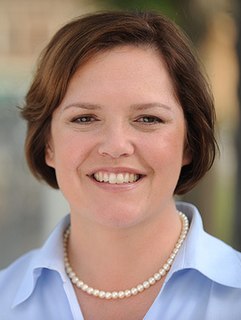
The Minnesota Legislature is the bicameral legislature of the U.S. state of Minnesota consisting of two houses: the Senate and the House of Representatives. Senators are elected from 67 single-member districts. In order to account for decennial redistricting, members run for one two-year term and two four-year terms each decade. They are elected for four-year terms in years ending in 2 and 6, and for two-year terms in years ending in 0. Representatives are elected for two-year terms from 134 single-member districts formed by dividing the 67 senate districts in half.

The Oklahoma House of Representatives is the lower house of the legislature of the U.S. state of Oklahoma. Its members introduce and vote on bills and resolutions, provide legislative oversight for state agencies, and help to craft the state's budget. The upper house of the Oklahoma Legislature is the Oklahoma Senate.

Melissa Hortman is an American politician and the Speaker of the Minnesota House of Representatives. She is a former Minority Leader of the Minnesota House of Representatives. A member of the Minnesota Democratic–Farmer–Labor Party (DFL), she represents District 36B, which includes portions of Anoka and Hennepin counties in the Twin Cities metropolitan area.

Margaret Anderson Kelliher is an American politician, current Commissioner of the Minnesota Department of Transportation, and a former member of the Minnesota House of Representatives. A member of the Minnesota Democratic–Farmer–Labor Party, she represented District 60A, which includes portions of the city of Minneapolis in Hennepin County, located in the Twin Cities metropolitan area. First elected in 1999, she served until 2011, also serving as the Speaker from 2007 to 2011. She is the second woman to hold the position of House speaker. She was an unsuccessful candidate for the DFL nomination for Governor of Minnesota in the 2010 gubernatorial election, losing to former Senator Mark Dayton. On June 5, 2018, she registered as a candidate for the DFL nomination to the U.S. House of Representatives in Minnesota's 5th congressional district, going on to lose in the primary.
Phil Carruthers is an American judge and former Minnesota politician and former member and Speaker of the Minnesota House of Representatives. He is also the former director of the Civil Division at the Ramsey County Attorney's Office. On September 14, 2011, Governor Mark Dayton appointed Carruthers as a judge to the Minnesota Fourth District Court.

Ron Erhardt is a politician from the U.S. state of Minnesota and former member of the Minnesota House of Representatives. He represented District 49A, which included most of Edina in Hennepin County.
The following table indicates the party of elected officials in the U.S. state of Minnesota:

Thomas M. "Tom" Bakk is a Minnesota politician and the minority leader of the Minnesota Senate. A member of the Minnesota Democratic–Farmer–Labor Party (DFL), he represents District 3, which includes portions of Cook, Koochiching, Lake and St. Louis counties in the northeastern part of Minnesota.

John A. Hartle was a Minnesota Republican politician and a Speaker of the Minnesota House of Representatives. Born on a farm, he became a livestock farmer himself. He was elected to the Minnesota House of Representatives in 1934. As a Republican, he caucused with the Conservative Caucus in the then-nonpartisan body.

Kurt Zellers is an American politician from Minnesota. He served as the Speaker of the Minnesota House of Representatives from 2011 to 2013 and as the Minority Leader of the Minnesota House of Representatives from 2009 to 2011. A member of the Republican Party of Minnesota, he represented District 34B in Hennepin County in the northwestern Twin Cities metropolitan area. He was a candidate in the 2014 Minnesota gubernatorial election, losing in the Republican primary.

The seventy-ninth Minnesota Legislature first convened on January 3, 1995. The 67 members of the Minnesota Senate were elected during the General Election of November 3, 1992, and the 134 members of the Minnesota House of Representatives were elected during the General Election of November 8, 1994.

The seventy-eighth Minnesota Legislature first convened on January 5, 1993. The 67 members of the Minnesota Senate and the 134 members of the Minnesota House of Representatives were elected during the General Election of November 3, 1992.

The seventy-fourth Minnesota Legislature first convened on January 8, 1985. The 67 members of the Minnesota Senate were elected during the General Election of November 2, 1982, and the 134 members of the Minnesota House of Representatives were elected during the General Election of November 6, 1984.
The Ninety-first Minnesota Legislature is the legislature of the U.S. state of Minnesota from January 8, 2019 to January 4, 2021. It is composed of the Senate and the House of Representatives, based on the results of the 2016 Senate election and the 2018 House election. It first convened and began its regular session in Saint Paul on January 8, 2019. It will end its regular session in 2019 not later than May 20 and may meet again from sometime in 2020 to not later than May 18, 2020.

The 1978 Minnesota House of Representatives election was held in the U.S. state of Minnesota on November 7, 1978, to elect members to the House of Representatives of the 71st Minnesota Legislature. A primary election was held on September 12, 1978.

The seventy-third Minnesota Legislature first convened on January 4, 1983. The 67 members of the Minnesota Senate and the 134 members of the Minnesota House of Representatives were elected during the General Election of November 2, 1982.

The seventy-first Minnesota Legislature first convened on January 3, 1979. The 67 members of the Minnesota Senate were elected during the General Election of November 2, 1976, and the 134 members of the Minnesota House of Representatives were elected during the General Election of November 7, 1978.













